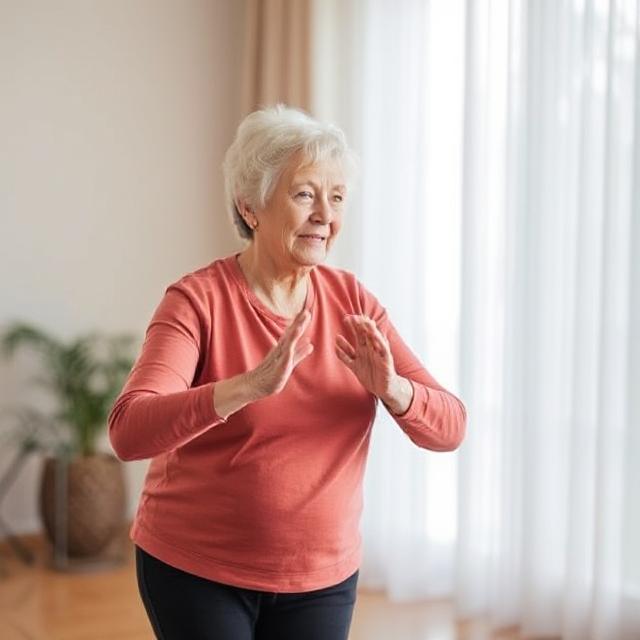Staying active is essential at any age, but for seniors with limited mobility, finding gentle and accessible ways to exercise can be a challenge. Thankfully, there are many options that promote strength, flexibility, circulation, and mental well-being without placing strain on joints or risking injury. The following exercises are designed to accommodate physical limitations while encouraging movement, independence, and overall health. Whether done seated, with support, or in the comfort of one’s home, these activities offer a safe and enjoyable way to keep the body engaged and the spirit uplifted.
1. Seated Leg Lifts
Seated leg lifts are an excellent way to build strength in the lower body without putting pressure on the joints. Begin by sitting upright in a sturdy chair with both feet flat on the floor. Slowly extend one leg out in front of you, keeping it straight and parallel to the ground. Hold this position for a few seconds, then lower it back down with control. Repeat on the other leg. This gentle movement engages the quadriceps and helps improve circulation and muscle tone. It can also contribute to better balance and coordination over time. Aim for 8–10 repetitions per leg, and take breaks if needed. For added benefit, you can incorporate ankle weights or resistance bands as strength builds. It’s important to focus on controlled movements and steady breathing during each repetition. This simple yet effective exercise can be done daily, and it’s ideal for seniors recovering from surgery or managing conditions like arthritis. It also helps in reducing stiffness and maintaining joint mobility, especially for those who spend a lot of time seated during the day.

2. Arm Circles While Seated
Arm circles are a fantastic upper body exercise that can be done easily while seated. Sit comfortably in a chair with your back straight and feet flat on the ground. Extend both arms out to the sides at shoulder height. Begin making small, controlled circles with your arms, rotating forward for 15–20 seconds, then reversing and circling backward for another 15–20 seconds. This exercise helps strengthen the shoulders, upper arms, and upper back muscles while also improving flexibility. It encourages blood flow to the upper body and can relieve tension built up from being sedentary. The circular motion stimulates joint lubrication and supports better posture. Arm circles also promote coordination and rhythm, making it a great activity to include in a morning or afternoon routine. Start with smaller circles and increase the size gradually as comfort allows. Always remember to breathe deeply and steadily throughout the movement. If fatigue sets in quickly, try fewer repetitions and gradually build up stamina over time. Arm circles are especially beneficial for individuals who may use mobility aids, as they help maintain upper body functionality and independence in daily tasks like reaching or lifting lightweight items.
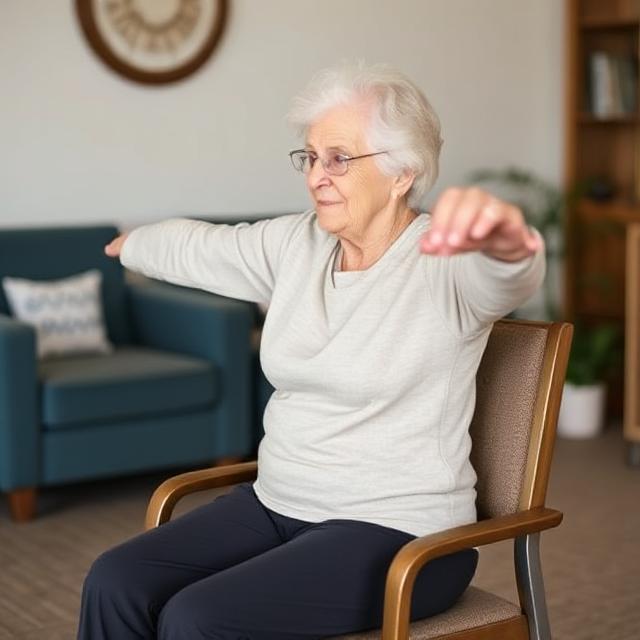
3. Chair Yoga Stretches
Chair yoga is a highly accessible form of yoga tailored for those with limited mobility. It involves performing gentle stretches and poses while seated or using a chair for support. Begin with a simple seated mountain pose by sitting tall, grounding your feet, and reaching your arms overhead with a deep inhale. Exhale and lower your arms gently. Continue with side stretches, gentle spinal twists, and shoulder rolls to loosen tension and enhance flexibility. These movements improve posture, relieve joint stiffness, and enhance range of motion in a safe and controlled manner. The emphasis on deep breathing throughout chair yoga promotes relaxation and reduces stress. It’s also beneficial for boosting mental clarity and mood. Practicing chair yoga regularly can help seniors feel more connected to their bodies, even with physical limitations. Modifications are easy to make, and movements can be adapted based on comfort level. It’s suitable for those dealing with chronic pain or recovering from illness. Engaging in chair yoga for even 10–15 minutes daily can significantly improve overall well-being and mobility. Always consult with a professional instructor for guidance or follow along with specialized video sessions made for seniors.

4. Seated Marching
Seated marching is a simple yet energizing cardiovascular exercise that can be done anytime. Sit comfortably in a straight-backed chair, keeping your feet flat and your hands resting on your thighs or the chair’s arms. Begin by lifting one knee toward your chest, then lowering it back down. Alternate legs in a marching rhythm. This activity mimics the natural motion of walking and helps improve circulation, heart health, and lower body strength. It can also aid in digestion and reduce swelling in the legs and feet. As coordination and endurance increase, you can lift the knees higher or add arm movements for a full-body effect. Seated marching is gentle on the joints and adaptable to various ability levels. It encourages rhythmic breathing and can also provide a mental boost by increasing oxygen flow. Seniors can do this exercise for several minutes at a time, depending on comfort, and it’s a great way to stay active while watching TV or listening to music. It’s especially useful for individuals recovering from surgery or managing mobility issues. Regular practice of seated marching supports cardiovascular fitness and functional mobility, helping maintain independence and energy throughout the day.

5. Wall Push-Ups
Wall push-ups are a safe and effective way to strengthen the upper body without needing to get down on the floor. Stand facing a wall at arm’s length. Place your palms flat against the wall, shoulder-width apart, and keep your feet hip-width apart. Slowly bend your elbows and lean toward the wall, keeping your body straight like a plank. Then, press back to the starting position. This movement targets the chest, shoulders, arms, and core, all while being gentle on the wrists and lower back. It’s a great alternative to traditional push-ups and can help maintain muscle tone and improve posture. Start with 8–10 repetitions and gradually build up as strength improves. Make sure the wall surface is sturdy and non-slippery to avoid accidents. Wall push-ups are particularly helpful for seniors who want to retain upper body strength needed for daily tasks such as lifting light objects, opening doors, or getting up from chairs. It also engages stabilizing muscles, supporting balance and reducing the risk of falls. Breathing evenly throughout the exercise and maintaining control are key to getting the most benefit without strain or discomfort.
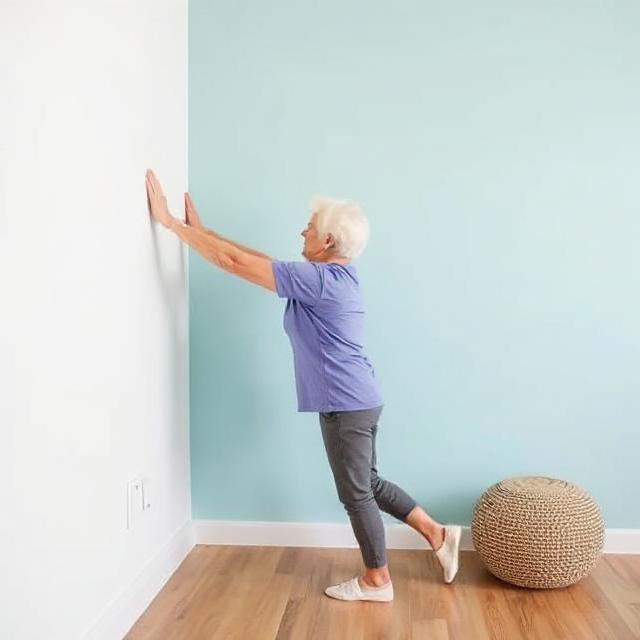
6. Ankle Rolls and Toe Taps
Maintaining mobility in the feet and ankles is essential for balance and preventing stiffness. Ankle rolls and toe taps are gentle exercises that can be performed while seated. Begin by sitting upright in a chair with your feet flat on the floor. Lift one foot slightly and rotate the ankle in a circular motion, first clockwise, then counterclockwise. Switch to the other foot and repeat. Follow this with toe taps by lifting the toes while keeping the heels grounded, then lifting the heels while keeping the toes down. These movements help increase circulation, reduce swelling, and maintain joint flexibility. They are especially beneficial for seniors who experience leg fatigue, neuropathy, or swelling from prolonged sitting. Regular ankle and foot exercises can improve walking stability and reduce the risk of tripping or falling. This routine also encourages better awareness and control of foot placement, which is vital for safe mobility. Doing these exercises daily, even for a few minutes, can make a noticeable difference in overall lower limb function. Add this to a morning routine or do it during television breaks for a productive and health-promoting habit.
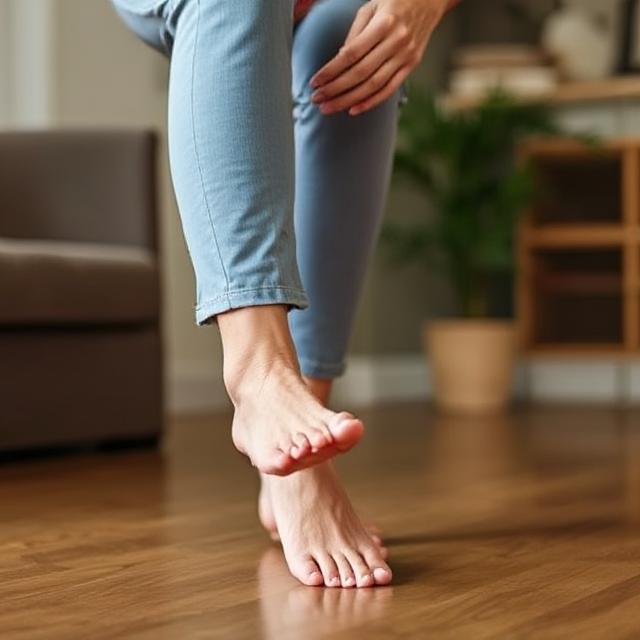
7. Resistance Band Arm Presses
Using a light resistance band for seated arm presses can build strength without needing heavy equipment. Sit upright in a chair and hold the resistance band at chest level, wrapping it behind your back or holding each end with your hands. Press your arms forward as if you’re pushing something away, then slowly return to the starting position. This exercise targets the chest, shoulders, and triceps, helping maintain muscle strength and joint flexibility. Resistance bands allow for controlled movement and can be adjusted in intensity by changing hand positions or band tension. Arm presses improve upper body endurance and can support better posture and functional strength for everyday activities like pushing doors or carrying groceries. Always move at a slow and steady pace, focusing on breathing and muscle engagement. This exercise can be done several times a week as part of a strength-building routine. Resistance band training is low-impact and ideal for seniors, especially those recovering from injury or dealing with arthritis. It promotes a sense of accomplishment and empowerment, making it not just a physical but also a mental wellness boost.
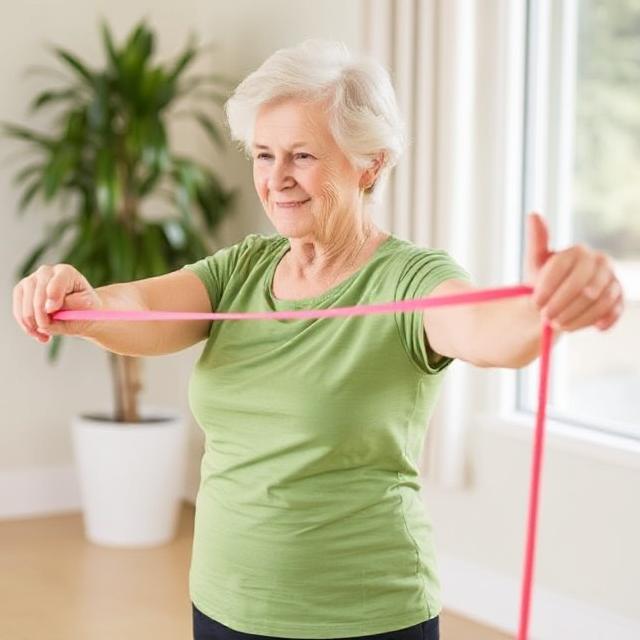
8. Neck and Shoulder Rolls
Neck and shoulder rolls are excellent for relieving tension and promoting flexibility in the upper spine and shoulders. Begin by sitting in a comfortable chair with a tall spine. Slowly drop your right ear toward your right shoulder, hold for a few seconds, then roll your head gently across your chest to the left side. Repeat several times, breathing deeply throughout. For shoulder rolls, lift your shoulders up toward your ears, then roll them back and down in a circular motion. Reverse the direction after several repetitions. These simple movements help ease stiffness caused by prolonged sitting or poor posture and can improve blood flow to the upper body. Neck and shoulder tension are common in seniors, especially those who use mobility devices or spend time seated. Regular stretching in this area can alleviate headaches, improve sleep, and enhance overall comfort. These movements are easy to do anytime—first thing in the morning, during a break, or before bedtime. They also pair well with mindfulness or meditation exercises, supporting both physical and mental relaxation. Consistent practice will contribute to better posture, reduced pain, and a greater sense of ease in daily life.
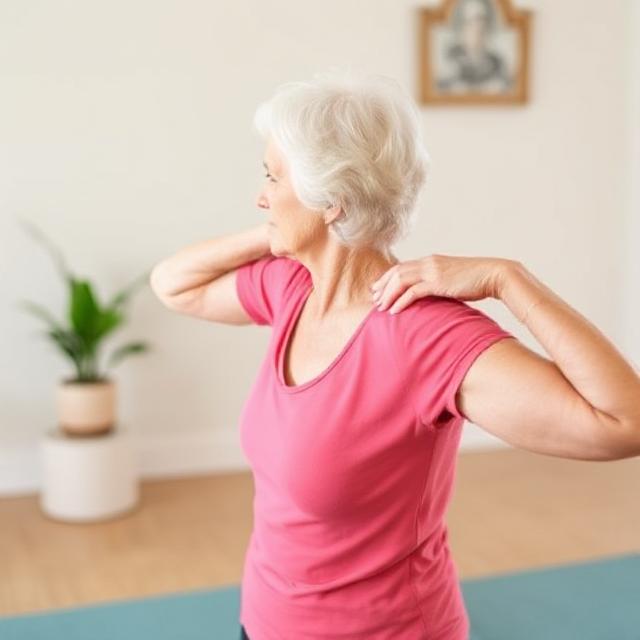
Exercise should be safe, enjoyable, and sustainable. For seniors with limited mobility, even small movements can make a significant difference in physical and emotional well-being. Incorporating these gentle exercises into a daily or weekly routine supports better circulation, joint flexibility, muscle strength, and balance. Always consult a healthcare provider or physical therapist before beginning a new routine, especially if there are underlying medical conditions. Consistency and patience are key—improvements come with time, and every little bit counts. The goal is to stay moving, stay positive, and honor the body’s needs with care and respect.
